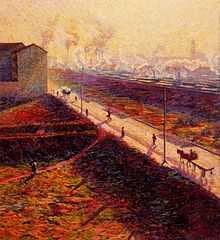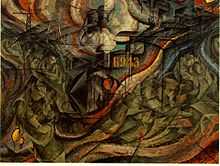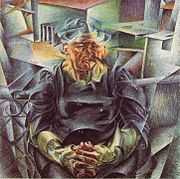Umberto Boccioni
| Umberto Boccioni | |
|---|---|
 Umberto Boccioni self-portrait (1905) | |
| Born |
19 October 1882 Reggio Calabria, Italy |
| Died |
17 August 1916 (aged 33) Verona, Italy |
| Nationality | Italian |
| Education | Accademia di Belle Arti di Roma |
| Notable work |
Unique Forms of Continuity in Space The City Rises The Street Enters the House |
| Movement | Futurism |
Umberto Boccioni (Italian pronunciation: [umˈbɛrto botˈtʃoːni]; 19 October 1882 – 17 August 1916) was an influential Italian painter and sculptor. He helped shape the revolutionary aesthetic of the Futurism movement as one of its principal figures. Despite his short life, his approach to the dynamism of form and the deconstruction of solid mass guided artists long after his death.[1] His works are held by many public art museums, and in 1988 the Metropolitan Museum of Art in New York organized a major retrospective of 100 pieces.[2]
Biography
Umberto Boccioni was born on 19 October 1882 in Reggio Calabria, the southernmost tip of mainland Italy. His father was a minor government employee, originally from the Romagna region in the north, and his job included frequent reassignments throughout Italy. The family soon relocated further north, and Umberto and his older sister Amelia grew up largely in Forlì (Emilia-Romagna), Genoa and finally Padua. At the age of 15, in 1897, Umberto and his father moved to Catania, Sicily, where he would finish school. Some time after 1898, he moved to Rome and studied art at the Scuola Libera del Nudo of the Accademia di Belle Arti di Roma.[3]
The little known about his years in Rome is found in the autobiography of his friend Gino Severini (1883-1966), who recalled their meeting in 1901 and mutual interest in Nietzsche, rebellion, life experiences and socialism. Boccioni's writings at this time already express the combination of outrage and irony that would become a lifelong characteristic. His critical and rebellious nature, and overall intellectual ability, would contribute substantially to the development of the Futurism movement. After building a foundation of skills, having studied the classics through Impressionism, both he and Severini became students of Giacomo Balla (1871-1958), a painter focusing on the modern Divisionist technique, painting with divided rather than mixed color and breaking the painted surface into a field of stippled dots and stripes. Severini wrote "It was a great stroke of luck for us to meet such a man, whose direction was decisive of all our careers."[3]

In 1906, he briefly moved to Paris, where he studied Impressionist and Post-Impressionist styles, before visiting Russia for three months, getting a first-hand view of the civil unrest and governmental crackdowns. Returning to Italy in 1907, he briefly took drawing classes at the Accademia di Belle Arti of Venice. He had first visited the Famiglia Artistica, a society for artists in Milan in 1901. After moving there in 1907, he became acquainted with fellow Futurists, including the famous poet Filippo Tommaso Marinetti The two artists would later join with others in writing manifestos on Futurism.[4]
Boccioni became the main theorist of the artistic movement.[5] "Only when Boccioni, Severini and a few other Futurists traveled to Paris and saw what Braque and Picasso had been doing did the movement begin to take real shape."[6] He also decided to be a sculptor after he visited various studios in Paris, in 1912, including those of Braque, Archipenko, Brâncuși, Raymond Duchamp-Villon and, probably, Medardo Rosso. In 1912 he exhibited some paintings together with other Italian futurists at the Galerie Bernheim-Jeune, and the following year returned to show his sculptures at the Galerie La Boétie: all related to the elaboration of what Boccioni had seen in Paris, they in their turn probably influenced the Cubist sculptors, especially Duchamp-Villon.
%2C_location_unknown%2C_destroyed.jpg)
"In the brief life span of the Italian Futurist movement, the short-lived Umberto Boccioni was a blazing comet. ... Boccioni was a fiery theoretician of the movement, drafting two Futurist manifestoes in 1910 and 1912 that exalted the force and energy of contemporary life. They called for an art that glorified speed, violence and the machine age, one that above all reflected the dynamism of an engine-driven civilization."[7] --Grace Glueck, New York Times Art Critic
In 1914 he published Pittura e scultura futuriste (dinamismo plastico) explaining the aesthetics of the group:
"While the impressionists paint a picture to give one particular moment and subordinate the life of the picture to its resemblance to this moment, we synthesize every moment (time, place, form, color-tone) and thus paint the picture.
He exhibited in London, together with the group, in 1912 (Sackville Gallery) and 1914 (Doré Gallery): the two exhibitions made a deep impression on a number of young English artists, in particular C.R.W. Nevinson, who joined the movement. Others aligned themselves instead to its British equivalent, Vorticism, led by Wyndham Lewis.
"Boccioni's gift was to bring a fresh eye to reality in ways that, we now recognise, defined the nature of the modern movement in the visual arts and literature, too."[8] --Michael Glover (art critic, The Independent)
In May 1916, he was drafted into the Italian Army to fight in WWI,[2] and was assigned to an artillery regiment at Sorte, near Verona. On 16 August 1916, he was thrown from his horse during a cavalry training exercise and was trampled.[9][10] He died the following day, age thirty-three.
Works


Early portraits and landscapes
From 1902 to 1910, Boccioni focused initially on drawings, then sketched and painted portraits - with his mother as a frequent model. He also painted landscapes - often including the arrival of industrialization, trains and factories for example. During this period, he weaves between Pointillism and Impressionism, and the influence of Giacomo Balla, and Divisionism techniques are evident in early paintings (although later largely abandoned). The Morning (1909) was noted for "the bold and youthful violence of hues" and as "a daring exercise in luminosity."[3] His 1910 Three Women, which portrays his mother and sister, and longtime lover Ines at center, was cited as expressing great emotion - strength, melancholy and love.[3]
Development of Futurism

Initially titled Il lavoro (Labor), Boccioni worked for nearly a year on La città sale or The City Rises, 1910, a huge (2m by 3m) painting, which is considered his turning point into Futurism. "I attempted a great synthesis of labor, light and movement" he wrote to a friend.[3] Upon its exhibition in Milan in May 1911, the painting attracted numerous reviews, mostly admiring. By 1912 it had become a headline painting for the exhibition traveling Europe, the introduction to Futurism. It was sold to the great pianist, Ferruccio Busoni for 4,000 lire that year,[3] and today is frequently on prominent display at the Museum of Modern art in New York, at the entrance to the paintings department.[1]

La risata (1911, The Laugh) is considered his first truly Futurist work. He had fully parted with Divisionism, and now focused on the sensations derived from his observation of modern life. Its public reception was quite negative, compared unfavorably with Three Women, and it was defaced by a visitor, running his fingers through the still fresh paint.[3] Subsequent criticism became more positive, with some considering the painting a response to Cubism. It was purchased by Albert Borchardt, a German collector who acquired 20 Futurist works exhibited in Berlin, including The Street Enters the House (1911) which depicts a woman on a balcony overlooking a busy street. Today the former also is owned by the Museum of Modern Art,[1] and the latter by the Sprengel Museum in Hanover.[3]

%2C_oil_on_canvas%2C_70_x_95_cm%2C_Gianni_Mattioli_Collection%2C_on_long-term_loan_to_the_Peggy_Guggenheim_Collection%2C_Venice.jpg)
Umberto Boccioni spent much of 1911 working on a trilogy of paintings titled "Stati d'animo" ("States of Mind"), which he said expressed departure and arrival at a railroad station - The Farewells, Those Who Go, and Those Who Stay. They are cited as defining the vastness and infinite possibility of Futurist painting and sculpture, and liberated from the academic frigidity of Cubism. Critics have claimed that he captured a "universal sensation," and today they are considered the summit of the Futurist aesthetic - "The atmosphere is literally shattered."[3] All three paintings were originally purchased by Futurist manifesto poet Filippo Tommaso Marinetti, until Nelson Rockefeller acquired them from his widow and later donated them to the Museum of Modern Art in New York.[1][11]
%2C_oil_on_canvas%2C_100_x_100_cm%2C_Museo_del_Novecento.jpg)
.jpg)
Beginning in 1912, with Elasticità or Elasticity, depicting the pure energy of a horse, captured with intense chromaticism, he completed a series of Dynamist paintings: Dinamismo di un corpo umano (Human Body), ciclista (Cyclist), Foot-baller, and by 1914 Dinamismo plastico: cavallo + caseggiato (Plastic Dynamism: Horse + Houses).
While continuing this focus, he revived his previous interest in portraiture. Beginning with L'antigrazioso (The antigraceful) in 1912 and continuing with I selciatori (The Street Pavers) and Il bevitore (The Drinker) both in 1914.
In 1914 Boccioni published his book, Pittura, scultura futuriste (Futurist Painting and Sculpture), which caused a rift between himself and some of his Futurist comrades. As a result, perhaps, he abandoned his exploration of Dynamism, and instead sought further decomposition of a subject by means of colour.[3] With Horizontal Volumes in 1915 and the Portrait of Ferruccio Busoni in 1916, he completed a full return to figurative painting. Perhaps fittingly, this last painting was a portrait of the maestro who purchased his first Futurist work, The City Rises.
Sculpture


The writing of his Manifesto of Futurist Sculpture, published in April 1914, was Boccioni's intellectual and physical launch into sculpture, as there are no known works before this period. Much of his experimental work from late 1912-1913 was destroyed, including pieces relating to contemporaneous paintings, which are known only through photographs.
Yet by the end of 1913 he had completed what is considered his masterpiece, Forme uniche della continuità nello spazio (Unique Forms of Continuity in Space), in wax. His goal for the work was to depict a "synthetic continuity" of motion, instead of an "analytical discontinuity" that he saw in such artists as František Kupka and Marcel Duchamp.[12] During his life, the work only existed as a plaster cast. It was first cast in bronze in 1931.[13] This sculpture has been the subject of extensive commentary, and in 1998 it was selected as the image to be engraved on the back of the Italian 20-cent euro coin.
Publications
- Article - Manifesto dei pittori futuristi, 1910 (Manifesto of Futurist Painters)[14]
- Article - Manifesto of Futurist Sculpture, April 1912
- Article - The Plastic Foundation of Futurist Sculpture and Painting, in Lacerba, March 1913 issue[15]
- Article - Esposizione di scultura futurista del pittore e scultore futurista, 1913[16]
- Article - Manifesto tecnico della scultura futurista, 1914[17]
- Book - Pittura, scultura futuriste (Futurist painting and sculpture), 1914[18]
Exhibitions
- Estorick Collection of Modern Italian Art, 2009 - Centenary of Marinetti's Futurist Manifesto, with 20 works[8][9]
- Solomon R. Guggenheim Museum, 2004 - Exhibition centered on Materia, with 23 other works.[19][20]
- Metropolitan Museum of Art New York, 1988 - Major Retrospective[2]
- Castelvecchio Museum Verona, 1985-1986 & Accademia di Brera Milan, 1986 & San Stae Venice, 1986 - Boccioni a Venezia
- Palazzo Reale di Milano, 1982-1983 & Kunstmuseum, Hanover, 1983 - Boccioni a Milano
- Palazzo Reale di Milano, 1973-1974 - Boccioni e il suo tempo
Gallery
-

States of Mind III; Those Who Stay, 1911, Museum of Modern Art, New York
-

Modern Idol, 1911, Estorick Collection of Modern Italian Art, Islington, London
-

Head + House + Light, 1912, sculpture destroyed
-
%2C_oil_on_canvas%2C_60.5_%C3%97_60.5_cm%2C_Von_der_Heydt_Museum.jpg)
Visioni simultanee, 1912, Von Der Heydt Museum, Wuppertal
-

L'antigrazioso, 1912, private collection
-

Dynamism of a Man's Head, 1913, private collection
-

Dynamism of a Soccer Player, 1913, Museum of Modern Art, New York
-

Development of a Bottle in Space, 1913, Metropolitan Museum of Art
-

Charge of the Lancers, 1915, Collection of Riccardo and Magda Jucker, Milan
-

Horizontal Volumes, 1915
References
- ↑ 1.0 1.1 1.2 1.3 "Museum of Modern Art - Umberto Boccioni in the Collection".
- ↑ 2.0 2.1 2.2 "New York Times, Sep. 16, 1988 - Met Retrospective Explores Boccioni And Futurism, by Michael Brenson". The New York Times. 16 September 1988.
- ↑ 3.0 3.1 3.2 3.3 3.4 3.5 3.6 3.7 3.8 3.9 3.10 Coen, Ester (1989). Umberto Boccioni. New York: The Metropolitan Museum of Art. pp. xiii–xvi. ISBN 0870995227.
- ↑ "New York Magazine, Mar. 1, 2004 - Futurist Tense by Mark Stevens".
- ↑ "New York Times, Feb. 13, 2004 - Blurring the Line Between the Present and the Future by Grace Glueck". The New York Times. 13 February 2004.
- ↑ "New York TImes, Nov. 3, 1989 - Out of the Past, the Spirit of Italian Futurism by Michael Kimmelman". The New York Times. 3 November 1989.
- ↑ "New York Times, Jul. 3, 1998 - On a Trip Back to Futurism, Women and Settings Merge by Grace Glueck". The New York Times. 3 July 1998.
- ↑ 8.0 8.1 "The Independent, Jan. 27, 2009 - Unique Forms: The drawing and sculpture of Umberto Boccioni by Michael Glover". London. 27 January 2009.
- ↑ 9.0 9.1 "The Guardian, Jan 17, 2009 - Impossible dreams of a speed freak by Laura Cumming". London. 18 January 2009.
- ↑ "Umberto Boccioni". Guggenheim Collection Online. Retrieved 3 December 2012.
- ↑ "Copy of Tate Gallery Immunity from Seizure filing, 2009" (PDF).
- ↑ Henderson, Linda (1981). "Italian Futurism and "The Fourth Dimension"". Art Journal (Art Journal, Vol. 41, No. 4) 41 (4): 317–323. doi:10.2307/776440. JSTOR 776440.
- ↑ "Met Museum, Description of Unique Forms of Continuity in Space, by Umberto Boccioni".
- ↑ "Manifesto dei pittori futuristi, by Umberto Boccioni, 2pp, Milano : Direzione del movimento futurista, 1910".
- ↑ "Lacerba (Journal), Firenze : Tipografia di A. Vallecchi e C., 1913-1915".
- ↑ "Esposizione di scultura futurista del pittore e scultore futurista, by Umberto Boccioni, 30pp, Roma : Galleria futurista, 1913".
- ↑ "Manifesto tecnico della scultura futurista, by Umberto Boccioni, 4pp, Venezia : Edizioni del Cavallino, 1914".
- ↑ "WorldCat Reference for Pittura, scultura futuriste (dinamismo plastico), by Umberto Boccioni, 472pp, Milano : edizioni futuriste di 'Poesia', 1914".
- ↑ "Guggenheim Museum Boccioni Exhibition Overview".
- ↑ "The Brooklyn Rail, Mar. 2004 - Boccioni’s Materia, A Futurist Masterpiece at the Guggenheim Museum by Jim Long".
- ↑ "Metropolitan Museum of Art, MetPublications Page for Umberto Boccioni".
Further reading
- Giovanni Lista, Futurisme : manifestes, documents, proclamations, L'Age d'Homme, coll. "Avant-gardes", Lausanne, 1973.
- Umberto Boccioni, Dynamisme plastique, textes réunis, annotés et préfacés par Giovanni Lista, traduction de Claude Minot et Giovanni Lista, L'Age d'Homme, coll. "Avant-gardes", Lausanne, 1975.
- Giovanni Lista, "De la chromogonie de Boccioni à l'art spatial de Fontana", in Ligeia, dossiers sur l'art, n° 77-78-79-80, juillet-décembre 2007, Paris.
- Giovanni Lista, Le Futurisme : création et avant-garde, Éditions L'Amateur, Paris, 2001.
- Danih Meo, Della memoria di Umberto Boccioni, Mimesis, Milano 2007.
External links
| Wikimedia Commons has media related to Umberto Boccioni. |
| Wikiquote has quotations related to: Umberto Boccioni |
- Umberto Boccioni papers, 1899-1986. Getty Research Institute, Research Library. Los Angeles, California.
- Umberto Boccioni, a full text exhibition catalog from The Metropolitan Museum of Art
|
